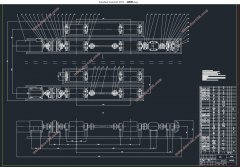ABS试验台的结构设计(含CAD装配图)

1.无需注册登录,支付后按照提示操作即可获取该资料.
2.资料以网页介绍的为准,下载后不会有水印.资料仅供学习参考之用.
密 惠 保
ABS试验台的结构设计(含CAD装配图)(任务书,开题报告,论文说明书13000字,CAD图3张)
摘要
当前,我国经济迅速发展,汽车保有量不断攀升,与此同时,各类交通安全事故频发,对人民生命财产安全造成极大威胁,因此,汽车安全性受到日趋重视。ABS是一项重要的汽车主动安全技术,因此,测试ABS性能十分必要。
本文通过在分析比较目前国内研究现状的基础上,较为系统地分析了汽车制动时动力学模型,综合汽车防抱制动装置工作基本原理,设计了ABS试验检测台架方案。该试验台可以为待测汽车提供模拟制动工况,在现有试验条件下,还原了较为真实的运行姿态,提高了检测精度和检测效率。论文比较了目前各种试验台架的优、缺点,选择了较为合理的布置方案。以电动机作为主动力源,以飞轮惯量模拟汽车运行惯量,利用滚筒带动受测汽车车轮转动,待汽车轮速略高于预定速度,切断电动机动力,在轮速下降至目标速度,进行刹车,传感器采集信号、软件分析试验数据并标定ABS性能参数。本文聚焦于试验台的结构设计,确定待测汽车的结构参数,设计选用电机型号和传动方案,选用标准零部件,设计非标准结构件,并分析了汽车在台架上的受力情况,据此对主要受力部件进行了应力、强度分析、校核,最终确定结构设计方案。在满足测试要求的基础之上,本文设计了双轮检测方案和整车检测方案,提高了台架的检测效率和通用性。双轮试验台架以不同配重的架车模拟真实汽车,ABS装置安装方便,可以快速检验ABS工作与否。整车试验台可以获取国标要求下的检测指标,检测结果较为精准,综合反映了ABS性能优劣。 [资料来源:www.THINK58.com]
关键词:ABS ,结构设计,惯量系统,双轮试验台,整车试验台
Abstract
At present, China’s economy is developing rapidly, and the number of car ownership continues to climb. At the same time, various types of traffic accidents are frequent and pose a great threat to the safety of people’s lives and properties. Therefore, the safety of automobiles has become increasingly important. ABS is an important vehicle active safety technology, so testing ABS performance is very necessary.
Based on the analysis and comparison of the current domestic research status, this article systematically analyzes the dynamic model of the vehicle braking, synthesizes the basic principles of the automobile anti-lock braking device, and designs the ABS test bench program. The test stand can provide simulated braking conditions for the car to be tested. Under the existing test conditions, a more realistic operating posture is restored, and detection accuracy and detection efficiency are improved. The paper compares the advantages and disadvantages of various test benches and selects a more reasonable layout. Taking the motor as the main power source, using flywheel inertia to simulate the running inertia of the car, using the drum to drive the wheel of the tested car to turn, until the wheel speed of the car is slightly higher than the predetermined speed, the motor power is cut off, and the wheel speed is decreased. To the target speed, brake, sensor acquisition signal, software analysis test data and calibration ABS performance parameters. This article focuses on the structural design of the test bench, determines the structural parameters of the car to be tested, designs the motor type and transmission scheme, selects standard components, designs non-standard structural components, and analyzes the stress of the car on the gantry. The stress, strength analysis, and check of the main force components were performed to finally determine the structural design scheme. On the basis of satisfying the test requirements, this paper designed a two-wheel detection scheme and a vehicle detection scheme, which improved the detection efficiency and versatility of the gantry. The two-wheel test bench simulates a real car with different weights, and the ABS device is easy to install. It can quickly check whether the ABS is working or not. The vehicle test stand can obtain the inspection indicators under the requirements of the national standard. The test results are more accurate and comprehensively reflect the performance of ABS.
[资料来源:http://THINK58.com]
Keywords: ABS, structural design, inertia system, two-wheel test bench, vehicle test bench
ABS性能检测的基本原理及台架方案设计
2.1 路面制动力产生原理
图2-1是车轮在制动时的受力图。Tμ是汽车制动器内的制动力矩;Fz为车架作用给车轮的垂直作用力,单位为N;Tp是车架对车轮的作用力,单位为N;W是地面对车轮的支持反力,单位为N;Fxb是地面制动力。
汽车刹车时,制动器作用给轮子与旋向反向的力矩,阻碍其滚动,道路作用反向的力Fxb,使轮速逐渐减低,直至停止。汽车的动能变为制动器的内能,并将热量扩散到空气中。制动器的温度、材料对其效能有不同程度的影响。
图2-2表示了路面、制动器制动力与地面附着力之间的关系。该图表明,在汽车制动的初期,Fμ相对较小,车轮未锁定。此时,Fxb与Fμ的大小相等,即Fμ=Fxb≤Fμmax,Fxb与Fμ的大小关系成正相关。由于Fxb的大小Fφ的大小限制,当Fμ的大小增大到一定程度时,Fxb达到其极大值Fμmax后,不随Fμ正相关增长,即Fxb ≤Fμ,此后Fxb的大小不再能够克服Fμ,车轮则会出现抱死拖滑现象。
由此可见,汽车的地面制动力首先取决于制动器制动力,但同时又受地面附着条件的限制,所以只有汽车具有足够的制动器制动力,同时路面又能提供高的附着力时,才能获得足够的地面制动力[ ]。
[资料来源:http://www.THINK58.com]




目录
摘要 I
Abstract II
第1章 绪论 1
[资料来源:www.THINK58.com]
1.1课题背景 1
1.2国内外的研究现状分析 1
1.3 课题的目的及意义 2
第2章 ABS性能检测的基本原理及台架方案设计 4
2.1 路面制动力产生原理 4
2.2 ABS的工作原理以及检测原理 5
2.2.1 汽车制动力系数与滑动率的关系 5
2.2.2 ABS的工作原理 5
2.2.3 ABS的检测原理 6
2.3设计方案的分析 6
2.4 双轮试验台架的分析 7
2.4.1 试验台结构简图 7
2.4.2 检测原理 7
2.4.3 试验台适用场合分析 7
2.5 整车模型的试验台设计 8
2.5.1 整车试验台构简图 8
图2-5为整车试验台的结构简图。 8
2.5.2 检测原理 8
2.5.3 整车试验台适用场合分析 8
第3章 整车试验台的结构设计 9
3.2 滚筒组转动惯量的分析 10
3.3 滚筒组转动惯量的选择 11
3.4.1 飞轮惯量的计算以及增速器的选择 11
3.4.2 飞轮尺寸的计算与选用 13
3.5 电机的选择 13
3.5.1 选择电动机的类型 13
3.5.2 选择电动机的型号 14
3.6 离合器的选择 15
3.7 轴的设计计算及强度校核 15
3.7.1 初选轴的直径 15
3.7.2轴的强度校核 16
3.7.3轴的CAE分析 18
3.8 联轴器的选择 19
3.9 轴承的选用与校核 20
3.9.1 选择的轴承类型 20
3.9.2轴承的校核 20
3.10 键的选择及设计 21
3.10.1 选择键的类型 21 [资料来源:http://think58.com]
3.10.2 键的校核 21
第4章 工作总结与展望 23
4.1 工作总结 23
4.2 工作展望 23
参考文献 24
致谢 25
上一篇:家用中型轿车前悬架设计(含CAD零件图装配图,CATIA三维图)
